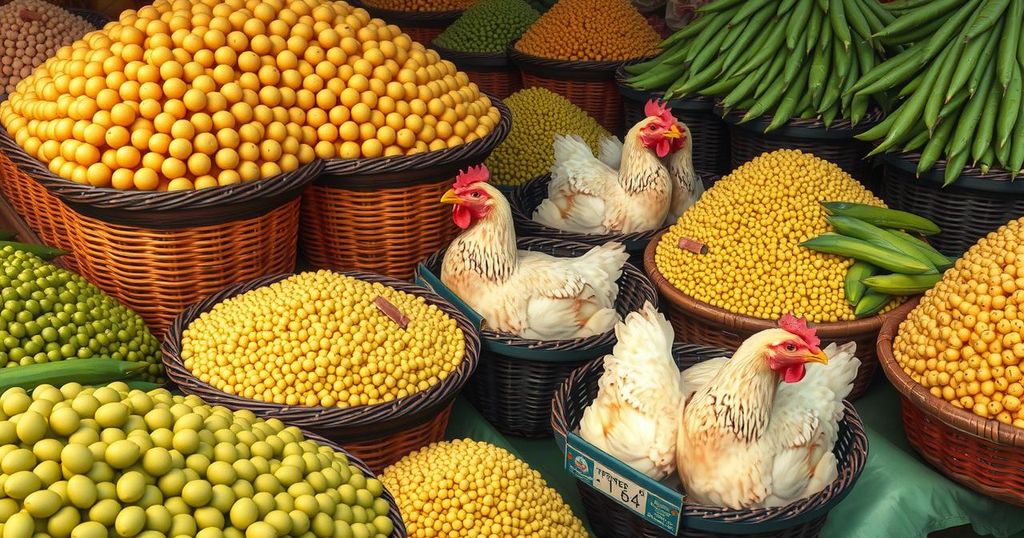In Zambia and Malawi, high soybean prices are threatening poultry production by significantly increasing feed costs. Market dynamics, including the influence of large buyers and adverse weather conditions, have led to declining soybean production and increased prices. The situation is detrimental to small producers who rely on competitive markets for feed, necessitating urgent attention to market regulation and support for the poultry industry.
Soybeans are fundamental for food security in Eastern and Southern Africa as they are a primary ingredient in poultry feed, which is the most affordable source of protein for the area’s rapidly growing population. In Zambia and Malawi, fluctuations in soybean pricing and production are posing significant challenges to the poultry industry, which heavily relies on these crops for feed. Poultry feed constitutes 60% to 70% of the total poultry production costs, and an increase in soybean prices directly impacts the affordability of poultry products and the competitiveness of producers, especially small-scale operations that purchase feed from the open market.
Both Zambia and Malawi are leading soybean producers in the region, yet they faced significant challenges in 2024, influenced by climate change and price dynamics within the soybean market. Zambia experienced a drastic 74% decline in soybean production due to adverse weather conditions and unfavorable pricing agreements with large buyers. In contrast, Malawi’s production dropped by 20%, but its soybean prices surged by 48%, resulting in the highest prices in the region despite having sufficient production capacity to export.
Our analysis at the African Market Observatory indicates that market concentration and lack of competition are critical factors influencing the price increases and production declines in both countries. The dominance of larger buyers in negotiating low prices severely limits the earnings of farmers, thus discouraging soybean planting. Additionally, the climatic challenges, particularly associated with the El Niño phenomenon, have compounded agricultural struggles in these regions.
The poultry sector, crucial for providing affordable protein and maintaining a lower environmental impact, is facing an impending crisis as the costs of feed escalate. Demand for poultry in sub-Saharan Africa is projected to quadruple by 2050, necessitating a focus on cost-effective feed solutions, particularly for small-scale producers who depend on competitive markets for their inputs. The rise in feed costs and prices for day-old chicks has resulted in negative profit margins for small producers in Malawi as they are unable to absorb increased expenses.
Historically, Zambia’s soybean output rose significantly from 297,000 tonnes in 2020 to 650,000 tonnes in 2023, but production plunged to 170,000 tonnes in 2024 as farmers decided to plant less due to poor pricing conditions and insufficient rainfall linked to the climate crisis. This declining trend is attributed to intense market pressures where farmers are compelled to sell their produce to a few dominant processors, who exploit their market position to set lower prices.
Throughout 2024, Malawi experienced skyrocketing soybean prices reaching nearly $900 per tonne by year-end, largely due to the tight market dynamics despite exceeding domestic production needs. In contrast, Zambia’s prices have stabilized, aided by imports and surplus soymeal, though the operations of processors have been limited by power outages.
This situation underscores the urgency of addressing competitive issues that threaten the resilience of regional food markets. Zambia is currently undertaking a poultry market inquiry, yet a comprehensive regional strategy is essential for monitoring market conditions and combating anti-competitive practices to bolster poultry production in Eastern and Southern Africa.
In summary, the escalating soybean prices in Zambia and Malawi are severely impacting poultry production costs and market stability. The dominance of large buyers in determining prices, alongside the adverse effects of climate change, is undermining the competitiveness of small producers. As the demand for poultry continues to rise, immediate and unified efforts are required to address competition concerns and ensure the resilience of food markets throughout the region.
Original Source: theconversation.com




